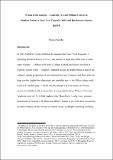Files in this item
Drama in the margins – academic text and political context in Matthew Gwinne's Nero: Nova Tragædia (1603) and Ben Jonson's Sejanus (1603/5)
Item metadata
| dc.contributor.author | Buckley, Emma | |
| dc.date.accessioned | 2018-08-28T23:33:33Z | |
| dc.date.available | 2018-08-28T23:33:33Z | |
| dc.date.issued | 2016-09-01 | |
| dc.identifier | 249017367 | |
| dc.identifier | 86261609-21a8-4187-b2dd-080c71706d3f | |
| dc.identifier | 84984940565 | |
| dc.identifier | 000383514500007 | |
| dc.identifier.citation | Buckley , E 2016 , ' Drama in the margins – academic text and political context in Matthew Gwinne's Nero: Nova Tragædia (1603) and Ben Jonson's Sejanus (1603/5) ' , Renaissance Studies , vol. 30 , no. 4 , pp. 602-622 . https://doi.org/10.1111/rest.12244 | en |
| dc.identifier.issn | 0269-1213 | |
| dc.identifier.other | ORCID: /0000-0002-7937-9134/work/60195530 | |
| dc.identifier.uri | https://hdl.handle.net/10023/15897 | |
| dc.description | Renaissance Studies Journal (Special Issue): Latin Drama, Religion and Politics in Early Modern Europe. Editors: Sarah Knight and Elizabeth Sandis. | en |
| dc.description.abstract | In the front matter to Matthew Gwinne’s Nero, John Sandsbury asserts that this history-play will supplant the ‘puerile’ pseudo-Senecan Octavia. My paper will explore this definition of the play as emulous academic exercise, through a comparative examination of Nero’s divorce and exile of Octavia in the pseudo-Senecan Octavia and Act IV of the 1603 Nero. Comparative reading of ‘text’ and ‘margin’ will, I argue, reveal a significant fissure between Octavia and Nero, above all in undermining the ‘apologetic’ drive of the pseudo-Senecan play, which seeks to disassociate Seneca from Nero’s tyranny and absolve the philosopher of any responsibility in the tragic fate of Octavia. I will then propose that the only post-antique sources Gwinne sidenotes in his text –John of Salisbury’s Policraticus (1159) and Savile’s The Ende of Nero (1591) – adumbrate this perspective further, for both these authors in different ways question the value of the doctrine of ‘absolute obedience’, a position Seneca conspicuously takes in the 1603 Nero. A third section will take this reading further, setting Nero against Jonson’s (1605) Sejanus to suggest that Nero is a text with genuine cultural impact, pointing the way for later authors who will find in Rome’s ancient history a potent way to speak to contemporary power. | |
| dc.format.extent | 797792 | |
| dc.language.iso | eng | |
| dc.relation.ispartof | Renaissance Studies | en |
| dc.subject | Academic drama | en |
| dc.subject | Matthew Gwinne | en |
| dc.subject | Ben Jonson | en |
| dc.subject | Margination | en |
| dc.subject | PN0441 Literary History | en |
| dc.subject | T-NDAS | en |
| dc.subject.lcc | PN0441 | en |
| dc.title | Drama in the margins – academic text and political context in Matthew Gwinne's Nero: Nova Tragædia (1603) and Ben Jonson's Sejanus (1603/5) | en |
| dc.type | Journal article | en |
| dc.contributor.institution | University of St Andrews. School of Classics | en |
| dc.contributor.institution | University of St Andrews. St Andrews Institute of Medieval Studies | en |
| dc.identifier.doi | https://doi.org/10.1111/rest.12244 | |
| dc.description.status | Peer reviewed | en |
| dc.date.embargoedUntil | 2018-08-29 |
This item appears in the following Collection(s)
Items in the St Andrews Research Repository are protected by copyright, with all rights reserved, unless otherwise indicated.

